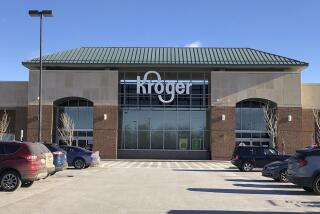Old and Improved: How Small Markets Compete
- Share via
Though Acords Market isn’t scheduled to close until next year, loyal shoppers are already lamenting the loss of a venerable Laguna Beach institution where residents have bought their groceries and stayed in touch for more than 50 years.
Acords and other independent markets have struggled for decades against big supermarket chains in a grueling competition that has driven many mom-and-pop grocers out of business. Nonetheless, dozens of others are surviving--and in some cases thriving.
Despite the hefty marketing muscle and buying power of Ralphs, Lucky and Vons, some smaller markets are holding their ground by offering “old-fashioned” services like home delivery and by stocking specialty products popular with nearby residents.
“People know you by your first name, and you know the clerks because they live down the street,” said Margaret Jones, a retired secretary who favors John’s Market on Main Street. “The supermarkets are so big and cold. . . . This is more how we used to shop.”
The resilience of neighborhood grocery stores can be seen in upscale communities like Seal Beach and Corona del Mar as well as ethnic enclaves in Santa Ana and Westminster, where independents face competition from both regular chains and large Latino and Asian supermarkets.
“The common factor is that the independents can spot trends and customize their stores more quickly because they don’t have the bureaucracy of the chains,” said Tom Schaffner, spokesman for Certified Grocers of California, a co-operative that supplies small markets.
Customized service is definitely the strategy at Seal Beach Market, which is just outside the Leisure World retirement community and caters primarily to senior citizens.
The store’s aisles are wider and its shelves lower than is typical in supermarkets, an accommodation for customers in wheelchairs or motorized carts. In recent years, the market has also reduced its stock of children’s cereals, pet food and baby products in favor of low-salt canned goods, colorful yarns and sewing materials.
“We got rid of the Lucky Charms and Kix cereals,” store manager Gary Rapport said. “We have more products in individual sizes and a whole aisle of dietary foods that our customers want.”
Leisure World resident Thomas Lyon said the special selection keeps him loyal. “It’s the only market around where you can buy six-packs of small prune juice cans.”
Customized service is the only way independents can survive against the big chains, which offer lower prices on many items because of their considerable buying power, Rapport said.
“We had no choice but to move in this direction. There’s no way we can compete when the chains are buying 10,000 cases of something and marking it down. We have to find other reasons for people to shop here.”
Experts estimate that Southern California independents hold a 14% share of the region’s grocery sales, a strong showing compared with other regions but a small fraction of their share 50 years ago.
Before warehouse stores and shopping centers, the corner market was a vital part of town life. Residents visited the compact shops several times a week, usually on foot, and formed close relationships with their grocers.
“People were loyal to those stores,” said Jerry Person, a Huntington Beach historian. “They offered credit because the bigger stores wouldn’t. People could run up a bill.”
The neighborhood markets that have survived continue to draw residents of all ages.
In Santa Ana, 13-year-old Maria Garza lives two blocks from McFadden Market, a small grocery store that caters to immigrant Latino families in the city’s working-class Heniger Park district.
Garza said she wanders into the market several afternoons a week with her friends. Together, they eye the selection of pinatas and Spanish-language fashion magazines before selecting a few pieces of Mexican fruit candy.
“This is our store,” she said.
More to Read
Inside the business of entertainment
The Wide Shot brings you news, analysis and insights on everything from streaming wars to production — and what it all means for the future.
You may occasionally receive promotional content from the Los Angeles Times.











